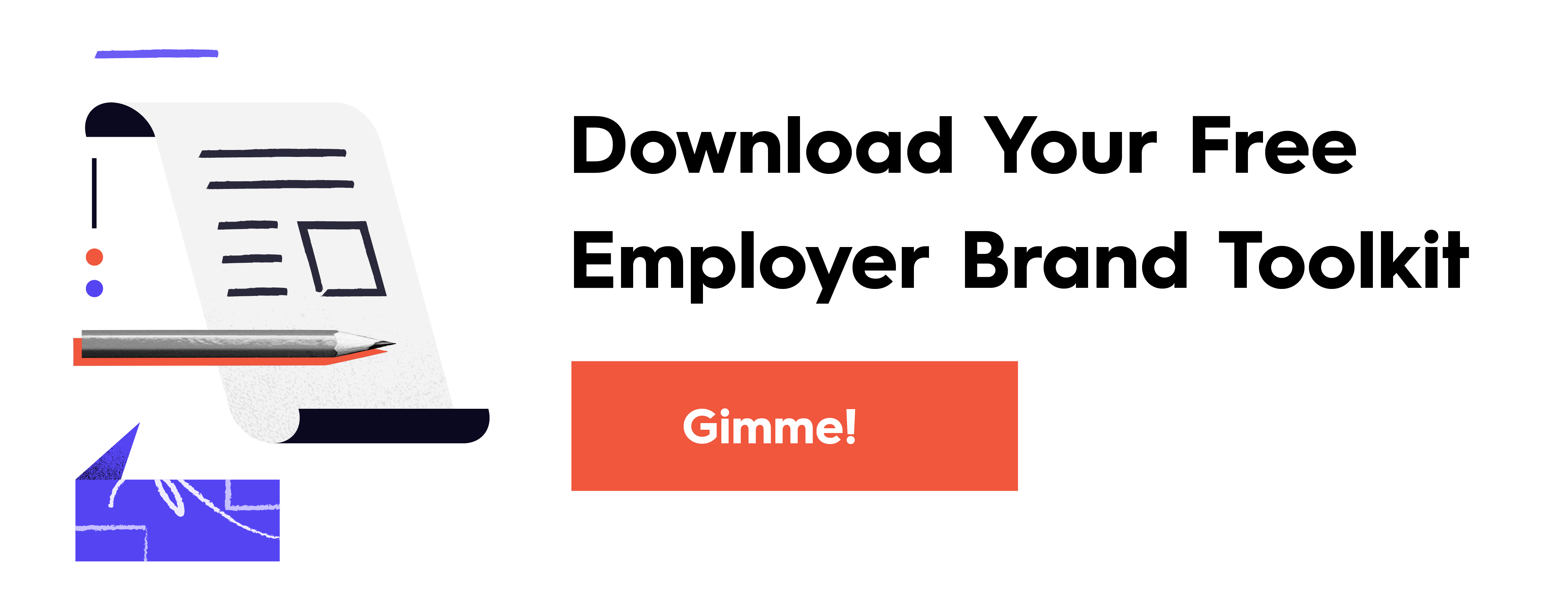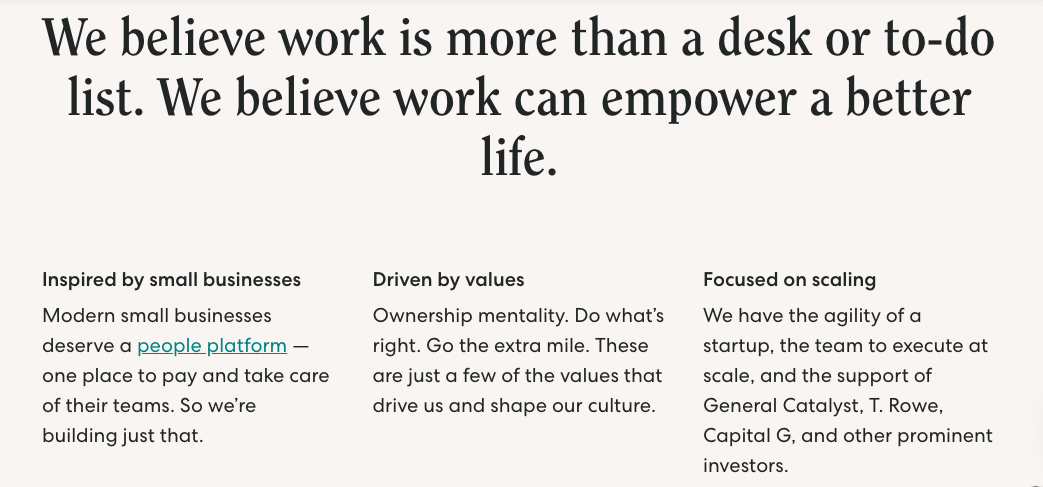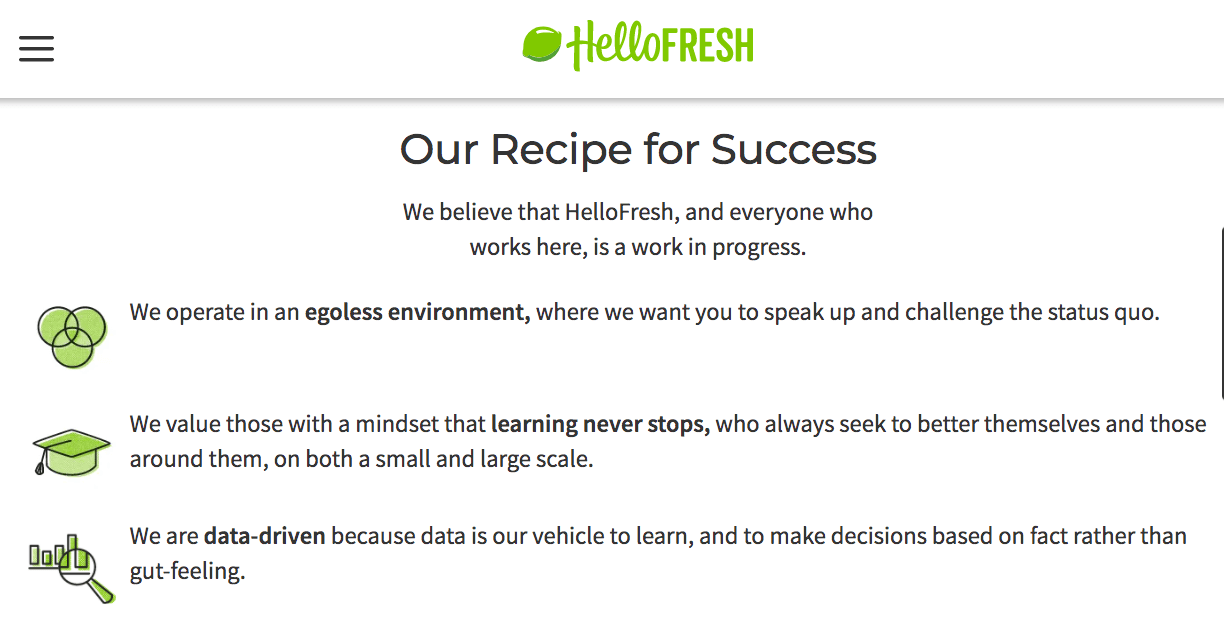Every brand is dealing with the same question: How do you find and keep the best employees? How do you capture people’s attention, inspire them to apply, and make them want to work with you for years to come? It comes down to your employer brand. When you know your brand’s value, understand who you are (and aren’t), and can communicate it well, the right people will come to you. Luckily, there’s one simple thing that makes communicating your brand a lot easier: a well-crafted employer value proposition.

What Is an Employer Value Proposition?
Similar to your brand’s value proposition, an employer value proposition (EVP) is an articulation of why your brand is unique and how it provides value. Instead of speaking to buyers and potential buyers, however, an EVP speaks directly to current and prospective employees. Ultimately, it’s a simple statement that answers a simple question (with a seldom simple answer): What makes your company a special place to work?
By highlighting who you are and what employees can expect, you can speak directly to the people who want to work toward your shared vision.
Example: Nike‘s EVP leads with a bold statement to entice others with a passion to push themselves.

Why Do You Need an Employer Value Proposition?
An EVP is a marketing tool, a vetting tool, and the foundation of your employer brand, helping you…
- Position yourself effectively in the recruiting market, showing employees and competitors where you stand.
- Attract the right kind of people by maintaining a consistent message across every employer brand touchpoint, from job descriptions to recruiting events. This is especially important as your brand evolves. Think about where you’re going and the type of people you’ll need to get you there. Your EVP should entice those people.
- Align current employees to a common purpose, reinforcing to them that they’re in the right place. Whether they see it this way or not, every day that someone shows up to work for a brand, they’re making an affirmative decision to do so.
- Keep you accountable through your actions, values, and culture. This is crucial if you want to retain the best and brightest.
Your EVP also works as a North Star to guide your decision-making and keep your brand on the right path in general.
How to Write Your Employer Value Proposition
An EVP isn’t necessarily hard to write, but it does require research and a methodical approach. Here’s how to get through the process smoothly.
Step 1: Complete an Employer Brand Audit
Before you can write a strong EVP, you need an honest and intimate understanding of who you are and what people think of you. An employer brand audit helps you get this information. By talking to prospective candidates, current employees, and alumni, you can get a clear picture of your strengths and weaknesses, why people like working for you, and what makes you special. You can’t articulate your EVP without these invaluable insights.
If you haven’t done this yet, follow our guide to complete your employer brand audit, which breaks down the steps to follow and the questions you need to ask to get the best insights.
Step 2: List Your Benefits
Once you’ve done a thorough audit, you should have a decent list of reasons why people like to work for you.
Warning: If you don’t have clear reasons, you have a larger problem to address. Don’t try to build an EVP based on what you want to be; new employees will quickly find out they’ve been sold a false bill of goods. They will come on as eager new hires and leave disgruntled, quickly. Recruiting leaders know how long it can take to find and hire the right candidate; the last thing you want is a high attrition rate for new hires.
To start, list out all of the benefits that surfaced during the audit. This can be a general list. You’ll refine them in the next step. But first, you want to make sure you haven’t left any highlights out.
Step 3: Identify Your 3 Main Pillars
Now, you’ll want to find the common themes in your list, and prioritize/consolidate the biggest benefits into three main pillars, which you will build your EVP around. (Note: Some brands use more than three, which is fine. But don’t use more than five.)
One helpful way to figure out what benefits to lead with is to separate them into two lists:
- What attracts people to your company
- What makes them stay
Once you’ve done that, you can compare the columns and look for common themes or through-lines in your employee experience that can be combined under one pillar.
Another easy way to pare down your list is to take a close look at your competitors. Among your 3-5 talent competitors, what’s being said? What’s not? Don’t worry about your benefits being absolutely differentiating at this point, but use competitive insights to inform where the “white space” in your industry may lie. (If you don’t know your talent competitors, here’s how to identify them.)
Example: Gusto’s EVP highlights their main pillars with personality.

Note: You can tailor different EVPs for different departments, offices, or regions, but they will always point back to the macro EVP that expresses what makes the company special.
Step 4: Workshop Your Rough Draft
With your pillars in mind, it’s time to start writing your EVP. You will ultimately want to come up with a few versions to review as a team.
At this stage, don’t let your self-consciousness block you. Don’t worry about the perfect wording. The point is to get your sentiment down.
Start by writing 3 sentences to describe each pillar. As you start to craft your full EVP, you can mix and match sentences to start to crystalize a single EVP.
As you narrow things down, ask yourself these questions to vet your statement drafts:
- Are they true, supported by the benefits and other insights you’ve collected in your foundational work?
- Do they differentiate you and say something unique from your competition?
- Will they resonate with your external customer brand (but not step on its toes)?
From there, you can distribute options to your team for feedback.
Step 5: Refine
Now is the time to tighten, trim, and add some color to your versions. As you work through them, make sure they’re:
- Succinct: They should communicate clear benefits and not overwhelm people with flowery language. Keep it short and sweet.
- Specific: The only thing worse than no EVP is a super generic one. Make sure to highlight what makes you unique. An easy way to figure out if you’ve done your job is to ask yourself, “Could my competitor use the same EVP?” Sure, there is some crossover in industries, but you should have enough clear benefits to differentiate.
- Descriptive: You have a huge opportunity to use language to paint a picture. Don’t get discouraged if it takes a few tries to get the wording right.
- On brand: It should capture your brand voice, personality, and tone.
Aim to end up with three separate versions of your EVP.
Example: Hello Fresh infuses their EVP with plenty of personality.

Step 5: Circulate & Iterate
Now comes the time for feedback. In addition to the direct team working on the EVP, try to solicit feedback from a cross-section of other employees, as well as past and current candidates, if possible. To quantify feedback, ask them:
- Are the benefits clear?
- Which version captures people’s attention more?
- Which one has a more emotional impact?
- Which one does the company deliver best on in the day-to-day experience of working here?
You will likely have a clear frontrunner or at least a firmer direction on where to take it. Iterate with your team until you have your strongest version.
How to Put Your EVP to Use
Once you have your employer value proposition, you have a great piece of content to support your brand. For next steps…
- Include it in job descriptions. As mentioned, your EVP isn’t the one-size-fits-all value prop for every job. It should be contextualized for the position you’re hiring for, with complementary benefits that speak to the persona you’re trying to reach.
- Update your web presence. Your EVP is a powerful piece of communication, which should be present across social channels. Make sure it’s featured on your Careers page (it can easily be used as the page header), and that it is represented on job search platforms like LinkedIn.
- Brainstorm content ideas. Your unique benefits can be great fodder for content. In fact, this type of content marketing is the key to a strong employer brand. Think of each benefit as its own pillar, and look for ways to translate those benefits into great content. For example, if your friendly culture is one of your benefits, highlight it through social media, videos, or blog posts.
One last thought: Keep in mind what while your EVP is the basis of your recruiting efforts, it isn’t a permanent piece of communication. As your brand evolves, your culture changes, and your company grows, it’s important to reassess whether or not it continues to reflect your brand’s unique value every couple of years. (See our complete guide to build an employer brand for more tips to keep your brand aligned.)
Of course, we know that this all requires the clarity and brain space to do this type of deep work. If your team is short on either (or feeling a little overwhelmed), let’s talk about how we can help you tell your employer brand story the best way.






